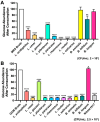Precision Probiotics Regulate Blood Glucose, Cholesterol, Body Fat Percentage, and Weight Under Eight-Week High-Fat Diet
- PMID: 41149620
- PMCID: PMC12566540
- DOI: 10.3390/metabo15100642
Precision Probiotics Regulate Blood Glucose, Cholesterol, Body Fat Percentage, and Weight Under Eight-Week High-Fat Diet
Abstract
Background/Objectives: Poor glycemic control is reaching an epidemic prevalence globally. It is associated with significantly morbid health concerns including retinopathy, neuropathy, nephropathy, cancer, and cardiovascular disease. Probiotics have shown promise in reducing health complications associated with poor blood glucose control. We tested a novel approach to designing a precision probiotic cocktail for improving blood glucose homeostasis. Methods: We tested the in vitro glucose consumption rate of twelve mouse microbiome bacterial strains and selected three with the greatest glucose consumption for the probiotic cocktail. The in vivo metabolic impact of ingesting the selected probiotic cocktail was evaluated in twelve C57BL/6J male mice fed a high-fat diet for eight weeks. Results: Compared to a control group, the probiotic group (L. rhamnosus, L. reuteri, and L. salivarius) exhibited significantly lower blood glucose levels, body weight, and body fat percentage. Moreover, the probiotic cocktail also demonstrated the ability to reduce serum insulin, total cholesterol, very-low-density lipoprotein/low-density lipoprotein cholesterol, and total cholesterol to high-density lipoprotein ratio. For further mechanistic investigation, untargeted metabolomics analyses uncovered overall downregulations in energy substrates and producing pathways like gluconeogenesis, acylcarnitine synthesis, glycolysis, the mitochondrial electron transport chain, the TCA cycle, and the building blocks for ATP formation. Partial least squares-discriminant analyses also confirmed clear group differences in metabolic activity. 16S rRNA sequencing from extracted gut microbiota also showed significant increases in Faith's phylogenetic diversity, Lachnospiraceae bacterium 609-strain, and the genus Muribaculaceae as well as group β-diversity differences after probiotic intake. Conclusions: As such, we successfully developed a blend of three probiotics to effectively reduce blood glucose levels in male mice, which could further mitigate adverse health effects in the host.
Keywords: Lactobacillus reuteri; Lactobacillus rhamnosus; Lactobacillus salivarius; blood glucose control; hyperglycemia; precision probiotics.
Conflict of interest statement
H.G. and P.J. are employed by the company MetaBiotics, LLC; P.J. is employed by the company Theriome Inc. The remaining authors declare that the research was conducted in the absence of any commercial or financial relationships that could be construed as a potential conflict of interest. All other authors declare no competing financial interests.
Figures











References
-
- Sun H., Saeedi P., Karuranga S., Pinkepank M., Ogurtsova K., Duncan B.B., Stein C., Basit A., Chan J.C., Mbanya J.C., et al. IDF Diabetes Atlas: Global, regional and country-level diabetes prevalence estimates for 2021 and projections for 2045. Diabetes Res. Clin. Pract. 2021;183:109119. doi: 10.1016/j.diabres.2021.109119. - DOI - PMC - PubMed
-
- Mouri M., Badireddy M. StatPearls. StatPearls Publishing; Treasure Island, FL, USA: 2023. Hyperglycemia. - PubMed
-
- Kianmehr H., Zhang P., Luo J., Guo J., Pavkov M.E., Bullard K.M., Gregg E.W., Ospina N.S., Fonseca V., Shi L., et al. Potential gains in life expectancy associated with achieving treatment goals in people with type 2 diabetes in the United States. JAMA Netw. Open. 2022;5:e227705. doi: 10.1001/jamanetworkopen.2022.7705. - DOI - PMC - PubMed
LinkOut - more resources
Full Text Sources
Research Materials

